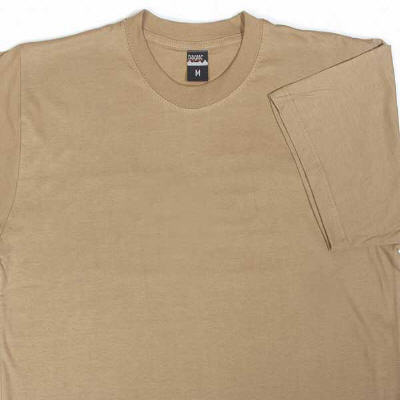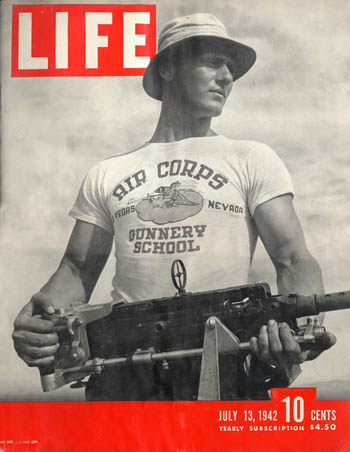History of the T-shirt During WW2
Published: Spring 2008
Author: Michael B. Kirby
Member: 2nd Squad Living History Group
The T-shirt came to the USA during WWI when US soldiers noticed the light cotton undershirts European soldiers were using while the US soldiers sweat in their wool uniforms. They quickly became popular among the Americans, and because of their design they got the name T-shirt. What became the modern T-shirt was developed in 1932 when officials from the University of Southern California Trojans football team (often credited to coach Howard Jones) asked Jockey International, Inc. to develop a inexpensive undergarment to absorb sweat and prevent a football player's shoulder pads from causing chafing. This resulted in the invention of the crewneck (or crew-neck) T-shirt. The shirts proved so popular that students started stealing them from the athletes and the athletic department reacted by stenciling "Property of USC" on each shirt, inadvertently making them even more popular. This became gradually more acceptable, as the cover of the July 13, 1942 issue of Life magazine shows, which features a picture of a soldier wearing a T-shirt with the text "Air Corps Gunnery School".This lead to the armed services as well as other sports teams actually screen-printing logos etc. on crew neck t-shirts. The Navy was the first of the armed services to adopt the crew neck t-shirt or “Gob Shirt” as it was sometimes called. Unlike modern crew neck t-shirts that fit loosely, these were tight fitting; thin cotton shirts that were made to absorb sweat. They had a wider neck with a thin band around the collar. The sleeves were much shorter than today’s t-shirts and usually fell as far as the lower portion of ones shoulder. The Marines also adopted the same style shirt as the Navy, however they were dyed Kelly green after complaints that their white color was impeding the ability for concealment. As a result many Marines dyed their white crew neck t-shirts in coffee early on.
During WW2 the Army chose to use the OD green “A” shirt or tank top style shirt. Again this was a thin cotton t-shirt used to absorb sweat in the field. Although these shirts were G.I. issue many soldiers chose to wear their own under garments reverting to using the crew neck style shirts.UPDATE:It has long been believed that there were no ribbed "A" or tank style shirts (aka "wife beater shirt"). There were in fact ribbed "A" shirts. The ribbed shirts were private purchase shirts and were fairly common. A ribbed "A" shirt was the sign of a "premium" or expensive undergarment. If you watch old movies you will notice this (if the character happens to remove his shirt!). A couple movies that show good examples of ribbed "A" shirts are: Buck Privates with Abbott and Costello. There is a scene where draftees are being weighed in, and you can see that Bud Abbott (Always in expensive suits) is wearing a ribbed "A " shirt. Also "In The Navy" with Abbott and Costello you will notice that singer Dick Powell is wearing a ribbed "A" shirt. Both movies were made prior to WW2 during the initial draft period. Characteristics of a premium "A" shirt would be the closed shoulders (where the material comes together) and ribbing both wide and small. Don't go out and buy any old ribbed "A" shirt!
The T-shirt had become standard issue underwear in the U.S. Army, Navy and Marines. Although the T-shirt was formally underwear, soldiers often used it without a shirt covering it while doing heavy labor or while stationed in locations with a hot climate. As a result, the public was frequently exposed to pictures of members of the armed forces wearing pants and a T-shirt.
After the war T-shirts started appearing without a shirt covering it in civilian life.FARB
CORRECT
Where to get good reproduction / modern T & A’s:
Kohls:
Sonoma life+style™ 3-pk. A-Shirts - $16.00Sears:
Structure Stretch Square Neck Tank - $7.80
Hanes
TAGLESS Ultimate Cotton Crewneck Women's T-Shirt - $14.00
WWII Impressions
Undershirt, Summer, Athletic - $19.99
90th IDPG Articles




